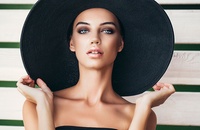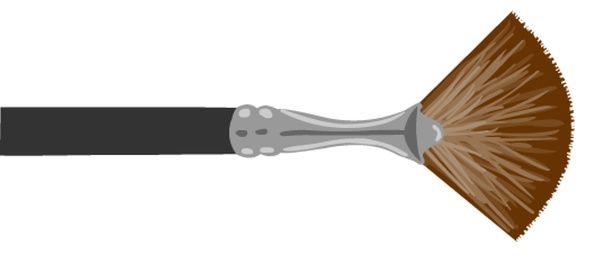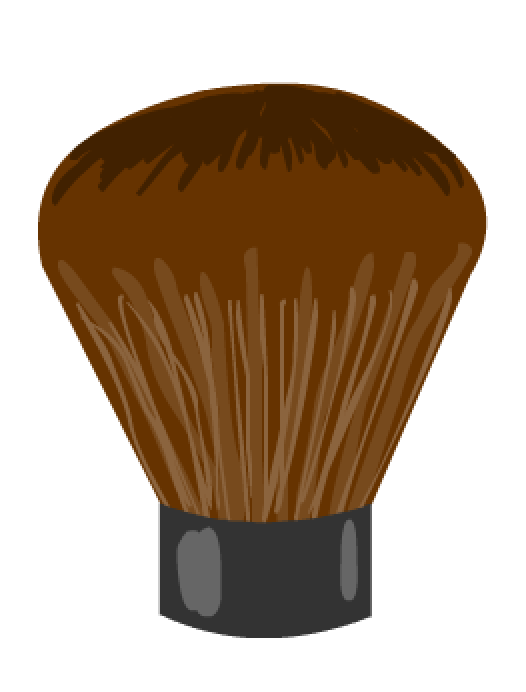The Handy Guide to Makeup Brush Sets
Large makeup brush sets full of pretty brushes, say unicorn or maybe mermaid brushes, are exciting, but all those different tools can leave even a hardcore beauty enthusiast puzzled. Why does the set include similarly shaped brushes in different sizes? What's the difference between natural- and synthetic-hair bristles? What are you supposed to do with that thing shaped like a mascara wand? To ease that confusion, we created a makeup brush guide that explains how to use makeup brushes in your collection.
Types of Brushes
Below, we explain how to identify and how to use 20 of the most common makeup brushes to help you get the most from your brand new makeup brush sets.
Eyes
Angled Liner Brush
Also known as: angled eyeliner brush, small angle brush, slanted eyeliner brush
Use it for: lining the eyes with eye shadow or gel eyeliner
Despite its name, an angled liner brush can be used for anything that needs a straight edge, such as drawing a border around lips with concealer or filling out the brows. These brushes are usually synthetic, since that material works best for gel products.
Eyeliner Brush
Also known as: liner brush
Use it for: precise eyeliner application
This brush's precision tip makes it perfect for creating a thin, smooth stroke along the lash line. Use it with liquid or gel eyeliner, or dip it in brightly colored eye shadow for a bolder look. On variations of this brush, the ferrule, or metal part, sits at an angle to encourage a more precise application.
Smudge Brush
Also known as: smudger brush
Use it for: applying shadow to the lash line or smudging out eyeliner
The dense bristle arrangement of the smudge brush makes it perfect for applying and blending bold bursts of color. It's especially good at smudging out pencil or gel eyeliner to create a smoky eye. Some smudge brushes have tiny sponge ends instead of dense bristles. These are best for smudging and softening lines.
Blending Brush
Also known as: blender brush, eye blender brush, eye shadow blender brush
Use it for: softening and blending eye shadow
This fluffy brush with soft bristles is designed not to apply color, but to blend it. Blending might be the most important step of any eye shadow application, as it smooths out rough lines and softens stark borders for a more professional look.
Eye Shadow Brush
Also known as: shadow brush, eye shader brush
Use it for: bold application of eye shadow
Whether you want an office-friendly pop of eye shadow or a head-turning evening look, this brush is what you'll use for shadow application. It doubles as a blending brush, as long as you remove any previously used color from its bristles.
Eye Shadow Sponge
Also known as: sponge applicator, sponge-tip applicator
Use it for: applying pressed or lightly pigmented eye shadow
Though this tool might puzzle some—don't people use makeup brushes so they don't have to use the little sponge that comes with every eye shadow palette?—it has its uses. For one, its absorbent qualities make it perfect for applying shadow that's prone to fallout, so you won't get speckles of shadow on your freshly blushed cheeks. It's also great for applying dry, chalky cosmetics that brushes can't pick up. And when you want to amp up the drama with a dense, heavy layer of shadow, the sponge applicator is your best bet.
(Note: These eye shadow sponge brushes are different than smudger brushes with a sponge tip. Smudger brushes have smaller sponges and again, are better for smudging, rather than applying, makeup.)
SHOP: EYELINER AND EYE SHADOW BRUSHES
Brows and Lips
Spoolie
Also known as: eyebrow brush, lash brush, spoolie wand
Use it for: grooming and shaping eyebrows
Your eyes deceive you: this is no mascara wand. It's designed specifically for the eyebrows, where it makes quick work of brushing brow hairs into place and applying brow gel. If you use it after filling your brows in, a spoolie can soften the color so it looks more like your natural eyebrows.
Brow and Lash Comb
Also known as: lash/brow groomer, lash comb and brow brush
Use it for: shaping and grooming brows and separating lashes after mascara application
Use the bristle side to shape and groom the eyebrows or to blend brow color for a more natural appearance. The comb side is used for separating mascara-darkened lashes, removing any clumps in the process.
Angled Eyebrow Brush
Also known as: slanted eyebrow brush
Use it for: defining and filling in brows
This brush looks nearly identical to the angled eyeliner brush (which you technically could use for the same purpose) with one difference—brow brushes are made with stiff, densely packed natural bristles. This stiffness makes it easier to apply heavier color underneath the brows. Use the slant to your advantage: holding the brush at a 45-degree angle works well for shading, while a 90-degree angle is great for creating precise lines.
Lip Brush
Also known as: lipstick brush, precision lip brush
Use it for: controlled application of lipstick and lip liner
This pointed brush plays a number of roles. If you use lip liner, the brush's precise, tapered bristles can blend the line inward and create a more natural-looking base for lipstick. You can also dip this brush into your liquid lipstick and use it to line your lips. Or, you use the brush to apply lip color all over the lips. After coating the bristles in color, apply it to the lips in thin layers. Start from the center and work your way out, so as not to overpower the corners with too much color.
SHOP: EYEBROW BRUSHES AND LIP BRUSHES
Face
Concealer Brush
Also known as: concealer blending brush
Use it for: applying and blending concealer
This densely packed brush is made to evenly distribute opaque liquid and cream formulas. Use it to apply concealer to any blemishes, under-eye circles, or discoloration, and then blend.
Contour Brush
Also known as: angled contour brush, contouring brush
Use it for: precise application of blush, contour, or bronzer
With firm bristles and an angled tip, this brush is designed to create a more defined line than its softer, rounder brush counterparts. That makes it perfect for creating the illusion of shadow under the cheekbones or jawline, or even adding a bold streak of blush to the cheeks.
Highlighter Brush
Also known as: highlight brush, tapered brush
Use it for: light application of highlight, blush, or shimmer powder
With loosely packed, soft bristles, this brush is designed to apply products that need to go on sparingly, such as brightly colored blush and intense shimmer. Try stippling a shimmery highlighter on the high points of your face, such as the cheekbones, nose, and center of the forehead.
Powder Brush
Also known as: large powder brush
Use it for: applying a light dusting of face powder
This big, fluffy brush full of loosely packed bristles will pick up just the right amount of pressed or loose powder. Just tap off any excess before you sweep it on.
Stippling Brush
Also known as: stipple brush, foundation stippling brush
Use it for: applying a light application of cream blush or highlighter
Usually a hybrid brush with finer fibers near the tip of each bristle, the stippling brush has a knack for creating an airbrush-style finish with liquid or cream foundation. Start by pouring a small amount of foundation on the back of your hand and gently tapping the brush into the liquid. Use that same tapping motion to distribute the foundation evenly all over your face, then gently swirl the bristles around over the applied foundation for an even finish.
Foundation Brush
Also known as: flat foundation brush
Use it for: applying liquid foundation
Like the stippling brush, the foundation brush is primarily designed to apply foundation. This paintbrush-esque makeup brush has bristles that are tightly packed together, making it perfect for picking up and applying foundation. For the best of both worlds, try using both brushes: apply foundation with the foundation brush, and then blend and finish with the stippling brush.
Blush Brush
Also known as: tapered blush brush
Use it for: a natural application of blush or bronzer
This soft, fluffy brush, which was designed for applying blush to the apples of the cheeks, creates a more subdued finish than the contouring brush. This brush comes in a variety of shapes, each designed for a particular application style. Try a few out to find the one that works for you.
Finishing Brush
Also known as: blending brush, face blending brush
Use it for: naturally blending makeup on the full face
Despite its name, this brush can be used to apply foundation, blend makeup, or both. Like eye shadow, face makeup should always be blended for the most natural appearance possible.
Fan Brush
Use it for: applying a light dusting of powder, highlighter, or shimmer
This gentle brush with sparse, soft bristles works well for sheer applications. Use it to apply a light touch of blush, shimmer, or bronzer on the cheeks, or even brush a clean fan brush under the eyes to remove any leftover flecks of shadow.
Kabuki Brush
Also known as: buffer brush
Use it for: applying an even application of face powder, bronzer, or blush, or for blending
Despite its name associations with the heavily made-up Japanese theater style, the kabuki brush is all about subtlety. Soft and fluffy, yet usually compact, the brush may be used to apply finishing powder or blush with a feathery finish. Its softness also lends itself to blending—simply swirl the brush in circles to soften any harsh lines in your foundation, blush, or contour.
SHOP: FACE BRUSHES
Brush-Bristle Materials
The bristles on makeup brushes come in one of three forms: natural, synthetic, or hybrid. You may find sets that include brushes made of one type of bristle, or a mix of each. That mix is usually by design, since each type of bristle lends itself to a specific type of makeup.
1. Natural Bristles
Made from real animal hair, natural bristles have a porous structure that makes them perfect for picking up color from powder cosmetics. However, they're not as ideal for cream and liquid products, and they can be harder to clean. Plus, if you have animal-hair allergies or care about being cruelty-free, you may want to stay away from natural bristles.
SHOP: NATURAL-BRISTLE BRUSHES
2. Synthetic Bristles
Because synthetic bristles aren't as absorbent as their natural counterparts, cream blushes and liquid foundation won't get trapped their bristles, and they blend eye shadow and other cosmetics to a natural finish without removing much color. They're still no match for natural bristles when it comes to applying powders.
SHOP: SYNTHETIC-BRISTLE BRUSHES
3. Hybrid Bristles
You can often spot hybrid brushes by their telltale two-tone design, as each individual bristle in is made of both natural animal hair and synthetic material. Combining these two materials creates a versatile tool that lends itself to applying and blending virtually any type of makeup.
Illustrations by Ashley Hamer for Groupon
RELATED READS
 How to Apply Bronzer
How to Apply Bronzer A step-by-step guide to nail your bronzer application, plus bronzer recs for each skin tone
 How to Contour in Four Steps (or One If You Don't Have Time)
How to Contour in Four Steps (or One If You Don't Have Time) This is what you're going to want to do when there's an alien invasion and you have only 12 seconds to contour before fleeing into the forest.
Deals on Makeup BrushesOther Deals in chicago

























